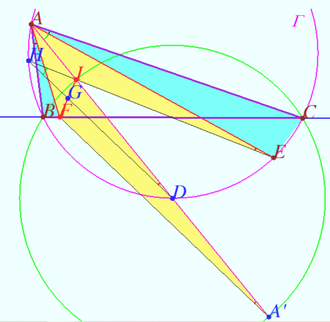2010 IMO Problems/Problem 2
Contents
[hide]Problem
Given a triangle ![]() , with
, with ![]() as its incenter and
as its incenter and ![]() as its circumcircle,
as its circumcircle, ![]() intersects
intersects ![]() again at
again at ![]() . Let
. Let ![]() be a point on arc
be a point on arc ![]() , and
, and ![]() a point on the segment
a point on the segment ![]() , such that
, such that ![]() . If
. If ![]() is the midpoint of
is the midpoint of ![]() , prove that the intersection of lines
, prove that the intersection of lines ![]() and
and ![]() lies on
lies on ![]() .
.
Authors: Tai Wai Ming and Wang Chongli, Hong Kong
Solution
Note that it suffices to prove alternatively that if ![]() meets the circle again at
meets the circle again at ![]() and
and ![]() meets
meets ![]() at
at ![]() , then
, then ![]() is the midpoint of
is the midpoint of ![]() . Let
. Let ![]() meet
meet ![]() at
at ![]() .
.
Observation 1. D is the midpoint of arc ![]() because it lies on angle bisector
because it lies on angle bisector ![]() .
.
Observation 2. ![]() bisects
bisects ![]() as well.
as well.
Key Lemma. Triangles ![]() and
and ![]() are similar.
Proof. Because triangles
are similar.
Proof. Because triangles ![]() and
and ![]() are similar by AA Similarity (for
are similar by AA Similarity (for ![]() and
and ![]() both intercept equally sized arcs), we have
both intercept equally sized arcs), we have ![]() . But we know that triangle
. But we know that triangle ![]() is isosceles (hint: prove
is isosceles (hint: prove ![]() ), and so
), and so ![]() . Hence, by SAS Similarity, triangles
. Hence, by SAS Similarity, triangles ![]() and
and ![]() are similar, as desired.
are similar, as desired.
Observation 3. As a result, we have ![]() .
.
Observation 4. ![]() .
.
Observation 5. If ![]() and
and ![]() intersect at
intersect at ![]() , then
, then ![]() is cyclic.
is cyclic.
Observation 6. Because ![]() , we have
, we have ![]() .
.
Observation 7. ![]() is a parallelogram, so its diagonals bisect each other, so
is a parallelogram, so its diagonals bisect each other, so ![]() is the midpoint of
is the midpoint of ![]() , as desired.
, as desired.
Solution 2
Let ![]() be A-excenter
be A-excenter ![]()
![]()
![]()
![]()
![]()
![]() the intersection of lines
the intersection of lines ![]() and
and ![]() lies on
lies on ![]() .
.
After pavel kozlov vladimir.shelomovskii@gmail.com, vvsss
See Also
| 2010 IMO (Problems) • Resources | ||
| Preceded by Problem 1 |
1 • 2 • 3 • 4 • 5 • 6 | Followed by Problem 3 |
| All IMO Problems and Solutions | ||










